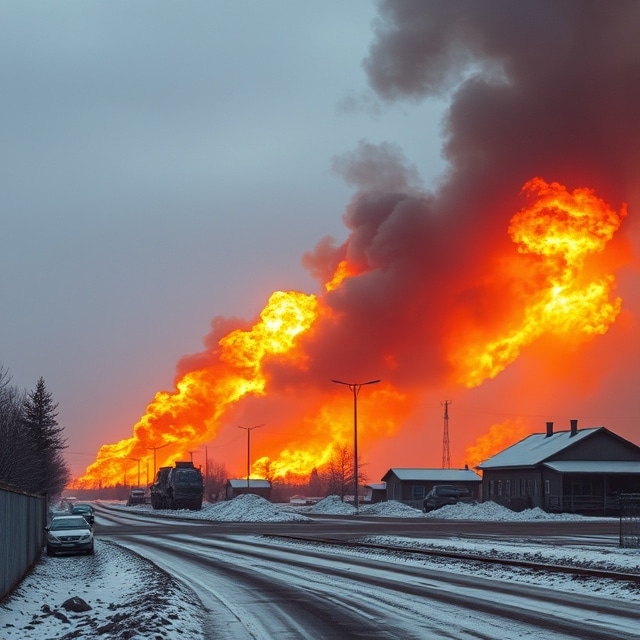Russia this morning threatened to strike US air bases in Poland with ‘advanced weapons’ hours after it reportedly launched an advanced missile as part of a brutal barrage of targets across Ukraine.
Moscow said the opening of a new US ballistic missile defence base in Redzikowo near the Baltic coast will ‘increase the overall level of nuclear danger’, adding it had been added to a list of possible targets for Russia.
The facility, opened on November 13, forms part of a broader NATO missile shield called ‘Aegis Ashore’ designed to intercept short- and intermediate-range ballistic weapons.
‘This is another frankly provocative step in a series of deeply destabilising actions by the Americans and their allies,’ Russian Foreign Ministry spokesperson Maria Zakharova said of the airbase’s unveiling.
‘(The base) has been added to the list of priority targets for potential destruction which, if necessary, can be executed with a wide range of advanced weapons,’ she concluded.
Her statement came minutes after Ukraine’s air force reported that a suspected ICBM had been fired from a base in Russia’s southern Astrakhan region on the Caspian Sea early this morning.
Russian authorities have not yet confirmed the launch, but if true it would be the first time such a powerful missile has been deployed in the war.
Some analysts expressed incredulity over reports of a fully-fledged ICBM being deployed, arguing that the reported range of the strike – roughly 700km or 454 miles – fell short of what would typically be expected of an intercontinental missile.
The alleged strike comes after Ukraine used US ATACMS and British Storm Shadow missiles to demolish targets inside Russia following approval by Sir Keir Starmer this week – something Moscow had warned for months would be seen as a major escalation.
Ukraine’s air force did not specify the missile that had been fired, but its launch comes mere hours after a Russian military analyst said Moscow’s forces could unleash its fearsome RS-26 ‘Frontier’ missile in retaliation for the Storm Shadow strikes.
The Frontier missile is a nuclear-capable weapon weighing roughly 36 tonnes with a range of up to 3,600 miles.
It has never before been used in combat, but analysts said it could be deployed with a conventional warhead in a strike that Ukraine’s air defences would be powerless to intercept.
Ukrainska Pravda, a Kyiv-based media outlet, cited anonymous sources saying the missile was indeed an RS-26 ‘Frontier’, a solid-fuelled ICBM that was first successfully tested in 2012.
Murky security camera footage out of the central-eastern city of Dnipro showed the moment warheads rained down over Yuzhmash, a prominent Ukrainian state-owned aerospace and defence manufacturer.
Experts said the use of an ICBM or similarly advanced long-range weapon to deliver conventional explosives was very costly, but that it served to illustrate how Moscow could dramatically escalate the conflict.
Dr Ruth Deyermond, Senior Lecturer in Post-Soviet Security at King’s College London, told MailOnline: ‘This strike has no obvious military value – they could achieve the same objectives without sacrificing an ICBM. It looks very much as if it’s signalling to the West what Russia could do if it chose to – launch a nuclear-armed missile.
‘But it’s actually a sign of weakness,’ she added. ‘The Russian government knows what would happen to it if they did attempt to use any kind of nuclear weapon, so they have to resort to bluffing.’
Dr Mattias Eken, a defence and security analyst at RAND Europe, expressed doubt the missile was in fact a fully fledged ICBM.
‘The reported range of 700km falls short of the typical intercontinental range, casting doubt on its classification as a full-fledged ICBM.
‘If the missile was indeed an ICBM, Russia would have been required to provide advance notification to the US to prevent triggering missile warning systems and possible retaliatory actions.’
The Russian attack this morning targeted enterprises and critical infrastructure, Ukraine’s air force said, at a time of escalating moves in the 33-month-old war.
The Kremlin deployed Tu-95MS strategic bombers to launch cruise missiles and MiG-31K fighters to fire hypersonic Kinzhal rockets in a calculated bid to plunge Ukraine into darkness as a bitter winter approaches.
Some Russian missiles reportedly struck the towns of Kremenchuk and Myrhorod, while areas in Kyiv, Odesa and Sumy regions suffered blackouts as the electrical grid gave out.










